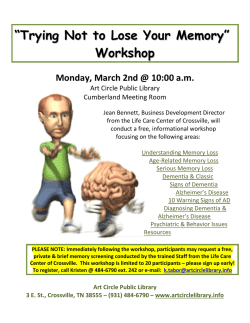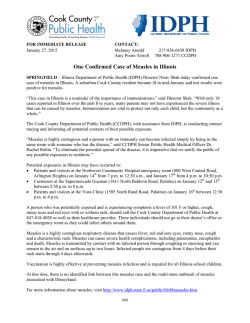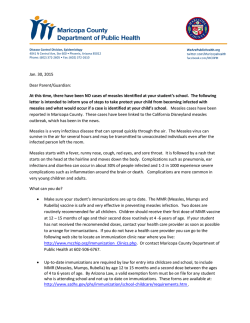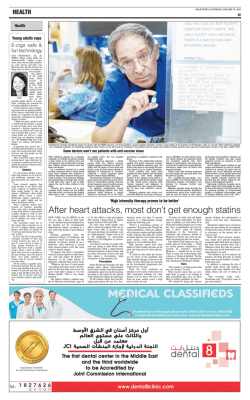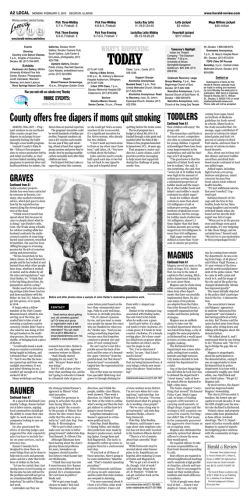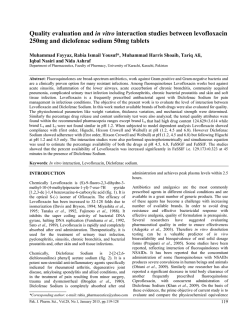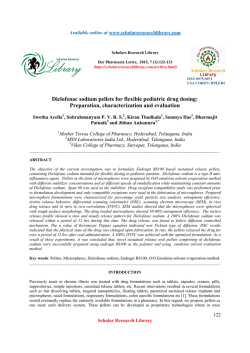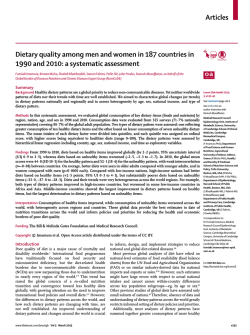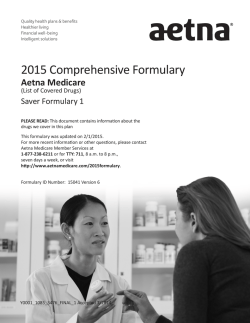
p28-29_Layout 1
TUESDAY, FEBRUARY 3, 2015 H E A LT H & S C I E N C E Insurers using drug costs to discriminate patients FORT LAUDERDALE: Insurance companies, perhaps more than previously thought, may be charging the sickest patients extra for drugs under the federal health law, in an effort to discourage them from choosing certain plans, according to a study released Wednesday. One of the cornerstones of President Obama’s signature health law forbids insurance companies from turning away people with pre-existing conditions such as diabetes or cancer. Yet hundreds of patient advocacy groups say insurance companies have found a way to discriminate against these people, who are more expensive to cover because they require life-long treatments. The companies do this by putting all of their medications in a special category where the patient is required to pay a percentage of the cost of the drug, rather than a flat co-pay. Some are as high as 50 percent, leaving people on the hook for thousands of dollars. That compares to the average $10 to $40 per-medication co-pay that most pay. A study published in the New England Journal of Medicine only examined HIV drugs, but noted the problem applies to mental illness, cancer, rheumatoid arthritis, diabetes and other chronic conditions. Patient advocates have complained that prescriptions for these patients were virtually unaffordable in some plans offered on healthcare.gov. The AIDS Institute even filed a formal complaint with Health and Human Services officials last summer about four plans in Florida. Georgia plans to file a similar complaint, but the scope of the problem has been difficult to gauge as many of the complaints have been anecdotal. The researchers studied 48 plans in 12 states using the federal marketplace: Delaware, Florida, Louisiana, Michigan, South Carolina, Utah, Illinois, New Jersey, Ohio, Pennsylvania, Texas, and Virginia. They found that one-quarter of the plans placed all of the HIV drugs into the highest-cost category and required consumers to pay at least 30 percent of the drug costs instead of a flat co-pay. Annual drug costs in these plans were more than triple compared with other plans ($4,892 to $1,615), according to the analysis. And 50 percent had to pay a separate deductible for drugs, compared to only 19 percent of consumers in other plans. Insurers have historically placed drugs in categories with higher co-pays to encourage consumers to select generic or preferred brand-name drugs. The problem is exacerbated as more plans place all drugs, including generics, in the more expensive category. “Our findings suggest that many insurers may be using benefit design to dissuade sicker people from choosing their plans,” the study noted. Over time, researchers predicted sicker people will enroll in plans that don’t charge such high prices. That means certain plans could have a higher number of sicker, more expensive consumers than their competitors. The federal law has financial protections for those plans but some will be phased out in 2016. The law does ban insurers from charging an individual more than $6,350 in out-of pocket costs a year and no more than $12,700 for a family policy. Insurance companies say the main issue is increasing drug costs and they’re shouldering the bulk of it. But they acknowledge the increased prices are also passed onto consumers. For example, Atripla, the most popular HIV AIDS treatment and one of the highest-selling drugs in the U.S., costs insurers $27,026 a year. Patients only pay a portion of that, said Clare Krusing, a spokeswoman for the trade association America’s Health Insurance Plans. But insurers noted consumers have the flexibility to choose from plans at all levels with different cost-sharing requirements and that the health law has a component that rewards plans for value and efficiency “not on their ability to attract healthier enrollees,” Krusing said. Advocates have asked federal health officials to intervene and nearly 300 patient groups sent a letter last month urging Health and Human Services Secretary Sylvia Burwell to beef up enforcement. The federal government has warned against such discrimination. “We analyze plan information submitted by insurance companies to uncover discriminatory benefit designs, and work with outlier plans to update formularies so they do not discourage enrollment of consumers with specific medical conditions,” agency spokesman Aaron Albright said in an email. It’s unclear what the penalties are for insurance companies who discriminate. Meanwhile, insurance officials in some states are stepping in. Three out of four insurance companies restructured their plans in Florida late last year. — AP ‘Still Alice’ highlights hidden toll of Alzheimer’s WASHINGTON: Her performance as a vibrant woman fading into the darkness of Alzheimer’s is doing more than earning awards for actress Julianne Moore. The movie “Still Alice” is raising awareness of a disease too often suffered in isolation, even if the Hollywood face is younger than the typical real-life patient. Some things to know about Alzheimer’s: ALZHEIMER’S IS INCREASING BUT THE EARLY-ONSET FORM ISN’T COMMON The movie is about a linguistics professor stricken at the unusually young age of 50 with a form of Alzheimer’s that runs in her family. That type of Alzheimer’s accounts for a small fraction of the brain-destroying disease. About 35 million people worldwide, and 5.2 million in the US, have Alzheimer’s or similar dementias. The vast majority are 65 or older. Barring medical breakthroughs, US cases are expected to more than double by 2050, because of the aging population. As many as 4 percent of cases worldwide are thought to be the early-onset form that strikes people before age 65, usually in their 40s or 50s, said the Alzheimer’s Association’s chief science officer, Maria Carrillo, who served as a scientific adviser for the movie. In the US, the association estimates that’s 200,000 people. GENE TESTING ISN’T RECOMMENDED FOR MOST PEOPLE Alice’s type is even more rare; she tells her three adult children in the movie: “It’s familial. It’s passed on genetically.” With this autosomal dominant form of young Alzheimer’s, inheriting one of three genes with particular mutations leads to the disease. Children of an affected parent have a 50 percent chance of having inherited the family’s culprit mutation. As in other families, Alice’s children have to grapple with whether they want to be tested to find out. But the vast majority of Alzheimer’s isn’t linked to a particular bad gene. There are various genes that can increase the risk, but people who never develop dementia symptoms can carry them, too. That’s why medical guidelines don’t recommend genetic testing for the average person. MANY SYMPTOMS ARE UNIVERSAL REGARDLESS OF AGE OF ONSET “I can see the words hanging in front of me and I can’t reach them, and I don’t know who I am or what I’m going to lose next,” Alice says. To help with the movie’s first-person perspective, Carrillo’s group put actress Moore in touch with someone in the earlier stages of Alzheimer’s who could describe how disorienting symptoms felt - that frustrating inability to retrieve a word or the fear that comes with suddenly not recognizing a familiar place. Forgetting a word now and then happens to lots of people. The Alzheimer’s Association lists warning signs that may distinguish between normal forgetfulness and something you should discuss with a doctor. On the worry list: memory loss that disrupts daily life, difficulty completing familiar tasks, withdrawing from social activities and personality changes. PEOPLE MAY COMPENSATE FOR A WHILE If it seemed like the movie’s Alice suddenly declined fast, consider a concept that neuroscientists call “cognitive reserve.” People who have had more years of education are thought to have some protection because the extra learning increased connections between their brain’s neurons. When Alzheimer’s begins blocking those connections, the brain at first can choose an alternate route to retrieve a memory. “Your brain’s kept buffered up,” explained Carrillo. But eventually, the brain reaches a tipping point and can’t compensate any longer, so “the change seems more dramatic.” WHAT’S IN THE PIPELINE There is no cure for Alzheimer’s, and today’s treatments only temporarily ease some symptoms. Scientists aren’t even sure what causes the disease, although a sticky brain protein called amyloid is one suspect. Nor is diagnosis simple. There is no one Alzheimer’s test, but a battery of evaluations. Sometimes, doctors use PET scans to measure amyloid buildup, but only in carefully selected cases because plenty of people without Alzheimer’s harbor the gunk, too. The Obama administration has declared a goal of finding effective Alzheimer’s treatments by 2025. Research suggests Alzheimer’s begins silently ravaging the brain up to 20 years before symptoms begin. One approach under study now is testing to see whether curbing sticky amyloid during that window period might at least postpone symptoms a few more years, if not prevent them. — AP CALIFORNIA: Pediatrician Charles Goodman vaccinates 1 year- old Cameron Fierro with the measles-mumps-rubella vaccine, or MMR vaccine. CALIFORNIA: Boxes of single-doses vials of the measles-mumps-rubella virus vaccine live, or MMR vaccine and ProQuad vaccine are kept frozen inside a freezer at the practice of Dr Charles Goodman.— AP photos Doctors won’t see patients with anti-vaccine views Approach raises questions about doctors’ ethical responsibilities LOS ANGELES: With California gripped by a measles outbreak, Dr Charles Goodman posted a clear notice in his waiting room and on Facebook: His practice will no longer see children whose parents won’t get them vaccinated. It’s a sentiment echoed by a small number of doctors who in recent years have “fired” patients who continue to believe debunked research linking vaccines to autism. They hope the strategy will lead parents to change their minds; if that fails, they hope it will at least reduce the risk to other children in the office. “Parents who choose not to give measles shots, they’re not just putting their kids at risk, but they’re also putting other kids at risk - especially kids in my waiting room,” the Los Angeles pediatrician said. The tough-love approach - which comes amid the nation’s secondbiggest measles outbreak in at least 15 years, with 95 cases or more since last month, most of them traced directly or indirectly to Disneyland in Southern California - raises questions about doctors’ ethical responsibilities. The American Academy of Pediatrics says doctors should bring up the importance of vaccinations during visits but should respect a parent’s wishes unless there’s a significant risk to the child. “In general, pediatricians should avoid discharging patients from their practices solely because a parent refuses to immunize his or her child,” according to guidelines issued by the group. ‘Betrayed and upset’ However, if the relationship between patient and doctor becomes unworkable, the pediatrics academy says, the doctor may want to encourage the vaccine refuser to go to another physician. Some mothers who have been dropped by their doctors feel “betrayed and upset,” said Dotty Hagmier, founder of the support group Moms in Charge. She said these parents made up their minds about vaccines after “careful research and diligence to understand the risks versus the benefits for their own children’s circumstances.” Dropping patients who refuse vaccines has become a hot topic of discussion on SERMO, an online doctor hangout. Some doctors are adamant about not accepting patients who don’t believe in vaccinations, with some saying they don’t want to be responsible for someone’s death from an illness that was preventable. Philosophical reasons Others warn that refusing treatment to such people will just send them into the arms of quacks. The measles-mumps-rubella vaccine, or MMR, is 97 percent effective at preventing measles, according to the Centers for Disease Control and Prevention. Measles spreads easily through the air and in enclosed spaces. Symptoms include fever, runny nose, cough and a rash all over the body. In rare cases, particularly among babies, measles can be deadly. Infection can also cause pregnant women to miscarry or give birth prematurely. All US states require children to get certain vaccinations to enroll in school. California is among 20 states that let parents opt out by obtaining personal belief waivers. Some people worry that vaccines cause developmental problems, despite scientific evidence disproving any link. Others object for religious or philosophical reasons. Nationally, childhood measles vaccination rates have held steady for years at above 90 percent. But there seem to be growing pockets of unvaccinated people in scattered communities, said Dr Gregory Wallace of the CDC. — AP CHICAGO: Kathy Burnett prepares a snack for her daughters Claudia, center, and Sabina right, after their gymnastics class Jan 29, in Chicago. Burnett says she tries to feed her girls healthy, natural foods rather than commercial packaged products. A study by the federal Centers for Disease Control and Prevention found that many packaged foods and snacks marketed for toddlers contain too much salt and sugar and could potentially contribute to childhood obesity and high blood pressure. — AP Toddler food often has too much salt, sugar CHICAGO: Many packaged meals and snacks for toddlers contain worrisome amounts of salt and sugar, potentially creating an early taste for foods that may contribute to obesity and other health risks, according to a new government study. About seven in 10 toddler dinners studied contained too much salt, and most cereal bars, breakfast pastries and snacks for infants and toddlers contained extra sugars, according to the study by researchers at the federal Centers for Disease Control and Prevention. They advise parents to read food labels carefully and select healthier choices. The researchers analyzed package information and labels for more than 1,000 foods marketed for infants and toddlers. Results appeared in the journal Pediatrics yesterday. The study notes that almost one in four US children ages 2 to 5 are overweight or obese - and that almost 80 percent of kids ages 1 to 3 exceed the recommended maximum level of daily salt, which is 1,500 milligrams. Excess sugar and salt can contribute to obesity and elevated blood pressure even in childhood, but also later on. “We also know that about one in nine children have blood pressure above the normal range for their age, and that sodium, excess sodium, is related to increased blood pressure,” said the CDC’s Mary Cogswell, the study’s lead author. “Blood pressure tracks from when children are young up through adolescence into when they’re adults. Eating foods which are high in sodium can set a child up for high blood pressure and later on for cardiovascular disease.” Healthy choices The researchers collected data on foods available in 2012. They didn’t list brand names, but foods studied included popular brands of baby food, toddler dinners including packaged macaroni and cheese, mini hot dogs, rice cakes, crackers, dried fruit snacks and yogurt treats. The Grocery Manufacturers of America, a trade group whose members include makers of foods for infants and toddlers, issued a statement saying the study “does not accurately reflect the wide range of healthy choices available in today’s marketplace ... because it is based on 2012 data that does not reflect new products with reduced sodium levels.” The study “could needlessly alarm and confuse busy parents as they strive to develop suitable meal options that their children will enjoy,” the group said. The researchers said theirs is the most recent, comprehensive data on commercial foods for young children. Cogswell acknowledged there have been some improvements in the marketplace and said the findings aren’t all negative. “The good news is that the majority of infant foods were low in sodium,” she said. It was surprising, she said, that “seven out of 10 toddler foods were high in the amount of sodium per serving and that a substantial proportion of toddler meals and the majority of other toddler foods and infant’s and toddler’s snacks contained an added sugar.” Switched brands Foods for toddlers should contain no more than about 210 milligrams of salt or sodium per serving, under Institute of Medicine recommendations, but the average for toddler meals studied was 361 milligrams - almost 1.5 times higher than that limit. Sodium amounts per serving ranged from 100 milligrams to more than 900 milligrams. High sugar content was defined as more than 35 percent of calories per portion coming from sugar, based on Institute of Medicine guidelines for foods served in schools. Many foods in the study exceeded that. On average, sugar contributed 47 percent of calories for infant mixed grains and fruit; 66 percent of calories in dried fruit snacks, and more than 35 percent of calories in dairy-based desserts.—AP
© Copyright 2025
